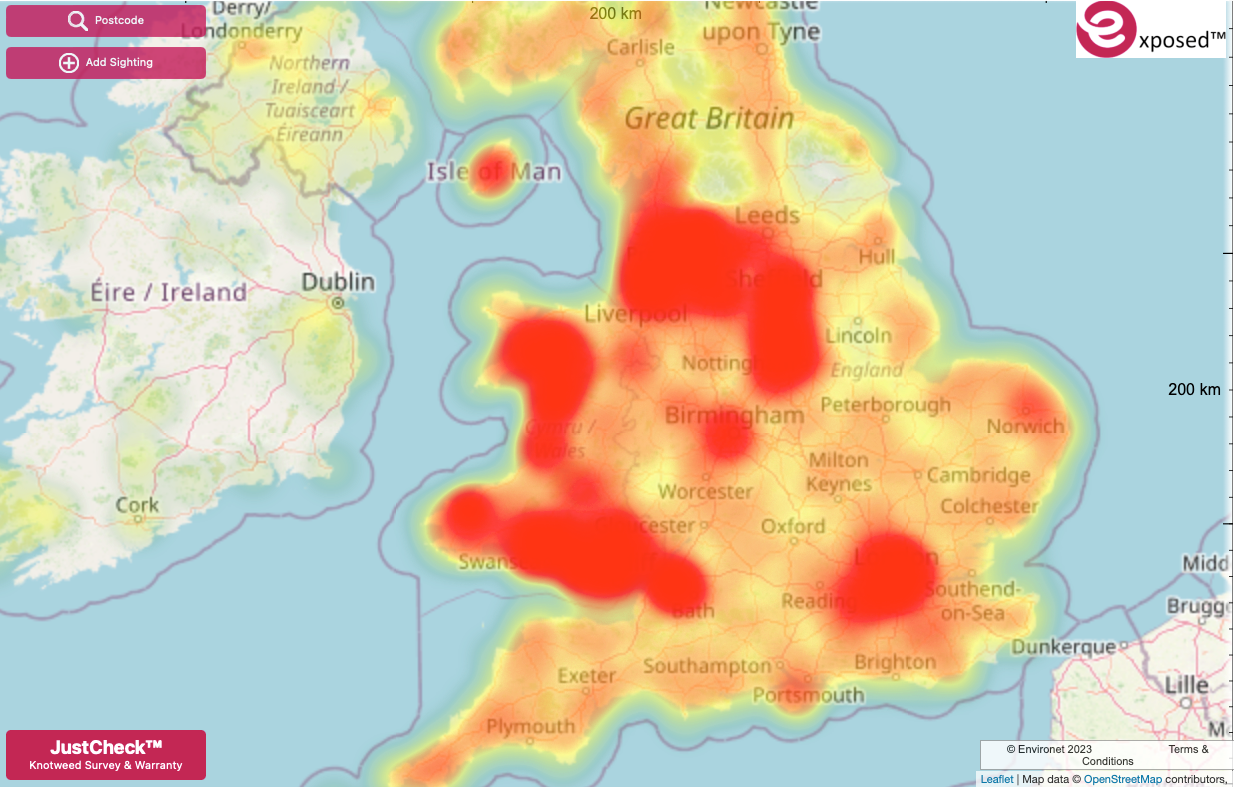Environet: 2023 Japanese knotweed hotspots revealed
Invasive plant specialist Environet has analysed the latest data from its live online tracker and reveals 2023 Japanese knotweed hotspots.
As Japanese knotweed’s summer growth period draws to a close, invasive plant specialist Environet has analysed the latest data from its live online tracker to reveal this year’s Japanese knotweed hotspots.
With over 50,000 known infestations across England and Wales, there is on average one occurrence of Japanese knotweed in every 3km². South Wales is one of the worst affected regions, with four locations on the national hotspots list – and nearby Bristol has the second highest number of sightings of any location in England after Bolton.
The Japanese knotweed hotspots for 2023 are:
|
Rank |
Location
|
No. of infestations |
|
1 |
Swansea, South Wales |
1,350 |
|
2 |
Bolton, Greater Manchester |
1,010 |
|
3 |
Bristol |
986 |
|
4 |
Cardiff, South Wales |
872 |
|
5 |
Preston, Lancashire |
857 |
|
6 |
Nottingham |
803 |
|
7 |
Derby |
711 |
|
8 |
Caernarfon, Gwynedd, North Wales |
708 |
|
9 |
Llanelli, Carmarthenshire, South Wales |
706 |
|
10 |
Bridgend, South Wales |
664 |
Charting the spread of Japanese knotweed across Britain, Exposed: The Japanese Knotweed Heatmap alerts homeowners and homebuyers to the risk level in their local area. Users can enter their postcode directly into the map to discover the number of verified knotweed sightings within a 4km radius, with hotspots highlighted in yellow, orange or, in the worst cases, red. They can also add sightings by uploading a photo to be verified by experts.
Japanese knotweed usually emerges in March or April and grows rapidly to reach up to 2.5 metres in height by mid-summer. It is identifiable by its hard, bamboo-like canes and distinctive shield-shaped bright green leaves which grow in a zigzag pattern along the stem.
Mature plants flower in August, becoming covered in clusters of delicate tasselled creamy-white flowers. Knotweed does not produce viable seeds as all the plants in the UK are female, so it is usually spread accidentally through the movement of soil or gardening waste, or via rivers and streams when pieces of rhizome break off and take hold in new locations.
Tackling knotweed costs the UK economy nearly £250 million a year and homeowners are one of the groups most at risk – not only from potential damage to their property, outbuildings and gardens, which can be costly to repair, but also from legal risks arising from encroachment or when properties are sold.
Whilst it isn’t illegal to have knotweed growing on your land, if it is allowed to cross a boundary into an adjacent property, legal disputes can arise between neighbours.
Similarly, when properties are sold, sellers are asked a direct question about whether knotweed is present, even if hidden beneath the ground or within 3 metres of the boundary, and those who fail to declare it can be sued by their buyer for misrepresentation.
Environet estimates that approximately 5% of homes across the UK are currently affected by Japanese knotweed, either directly or neighbouring an affected property, typically impacting property prices by around 5% – or up to 10% in severe cases.
Nic Seal, founder of Environet, said:
“Vigilance is the best way to protect your property from the risks posed by Japanese knotweed.
“Make sure you know what knotweed looks like and how it differs from other common garden weeds like ivy and bindweed, so you can keep an eye out for it in your garden and neighbourhood.
“Knotweed is easily identifiable during summer, but as we head through the autumn and into winter, the above-ground growth dies back, and it becomes much harder to spot.
“It’s also easier to conceal, so anyone viewing a property to buy should be extra careful.
“There are lots of horror stories out there but the with professional help, knotweed can be successfully treated, and a property’s value can be largely restored.”

2023 Japanese knotweed hotspots in Great Britain (Credit: Environet)
What to do if you spot Japanese knotweed:
-
- Email a photo of the plant to Environet’s free ID service at [email protected]
- Commission a professional Japanese knotweed survey to confirm the extent of the infestation, where it originated and the best way to treat it.
- Put a professional treatment plant in place with an insurance-backed guarantee. The DART™ method is a very cost-effective treatment during the autumn and winter, which involves removing the bulk of the knotweed rhizome from the ground while the garden isn’t in use and herbicide treating any minor regrowth that occurs next spring.
- If you’re selling your property, inform the estate agent at the outset and even if the infestation is removed, be sure to declare it to potential buyers on the TA6 form.
- If you’re unsure whether your property or one you wish to buy is affected by knotweed, commission a JustCheck™ survey. Experts will check the property and its immediate surroundings for any sign of the invasive plant.
Kindly shared by Environet


















